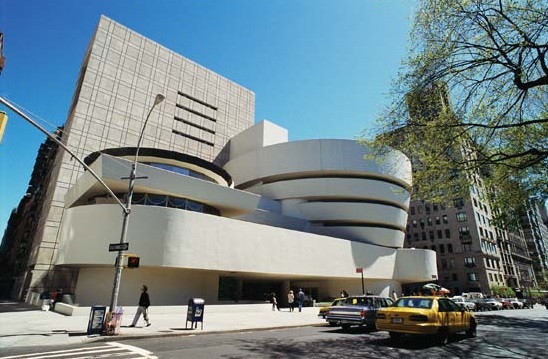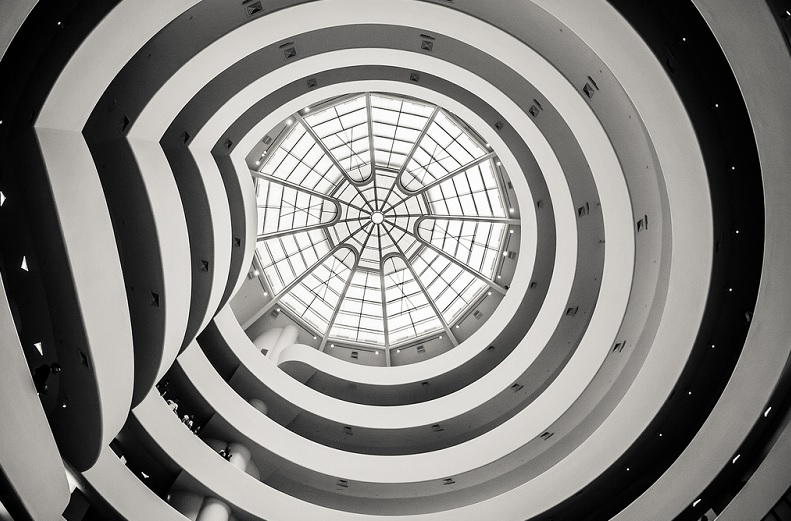Solomon R. Guggenheim Museum
Contents |
[edit] Introduction
The Solomon R. Guggenheim Museum is an art museum located on Fifth Avenue in the Upper East Side neighborhood of Manhattan, New York City. Designed as a distinctive cylindrical form by the architect Frank Lloyd Wright, it is widely acknowledged to be a landmark example of the International Style.
Originally known as the Museum of Non-Objective Painting, the museum was first established by the Solomon R. Guggenheim Foundation in 1939, but in a different location. In the late-1940s, plans were made to move, and Frank Lloyd Wright was commissioned to design a new ‘temple of the spirit’.
It was the only museum Wright designed and would prove to be his final project, as he died six months before its official opening in October 1959. It provoked a mixed response, with some critics calling it ‘the most beautiful building in America’, while others believed the architecture detracted from the art itself, calling it ‘less a museum than a monument to Wright’.
It is now a popular tourist attraction, with around 1.3 million visitors a year.
[edit] Design and construction
Wright was not particularly keen on the idea of designing a building for the ‘overbuilt and overpopulated’ Manhattan. However, after considering several locations he chose the Fifth Avenue site because of its close proximity to Central Park. The urban location meant Wright had to design the building vertically rather than horizontally, in a form that was a departure from the rural works with which he was associated.
He settled on a cylindrical form, with a wider top than base, and the appearance of a white ribbon curled into a stack, in stark contrast to the typically-rectangular buildings that characterised Manhattan.
Wright’s design dispensed with the conventional approach to museum layout. He conceived a continuous helical ramp on a gentle slope that spirals around the outer edges of the building. This allows visitors to view the 92 m-high atrium that rises to an expansive glass dome, while passing several bays of artwork on different levels, creating ‘one great space on a continuous floor’.
In terms of function, a number of artists raised doubts about his design. The shape of the interior walls meant paintings had to be tilted backward, and there were difficulties hanging linear artworks on concave surfaces.
The construction of the building was delayed by World War II, during which, the cost of building materials rose. Construction actually began in 1956 and was completed in 1959.
[edit] Subsequent construction
The museum has been changed a number of times since its completion. There was a major expansion and renovation in 1990-92, when Wright’s original plan for an adjoining sandstone tower was realised. In addition, the atrium skylight, which had been covered, was restored to its original design.
Between 2005 and 2008, the museum underwent exterior restoration to repair cracks and modernise climate-control systems.
[edit] Find out more
[edit] Related articles on Designing Buildings Wiki
Featured articles and news
RTPI leader to become new CIOB Chief Executive Officer
Dr Victoria Hills MRTPI, FICE to take over after Caroline Gumble’s departure.
Social and affordable housing, a long term plan for delivery
The “Delivering a Decade of Renewal for Social and Affordable Housing” strategy sets out future path.
A change to adoptive architecture
Effects of global weather warming on architectural detailing, material choice and human interaction.
The proposed publicly owned and backed subsidiary of Homes England, to facilitate new homes.
How big is the problem and what can we do to mitigate the effects?
Overheating guidance and tools for building designers
A number of cool guides to help with the heat.
The UK's Modern Industrial Strategy: A 10 year plan
Previous consultation criticism, current key elements and general support with some persisting reservations.
Building Safety Regulator reforms
New roles, new staff and a new fast track service pave the way for a single construction regulator.
Architectural Technologist CPDs and Communications
CIAT CPD… and how you can do it!
Cooling centres and cool spaces
Managing extreme heat in cities by directing the public to places for heat stress relief and water sources.
Winter gardens: A brief history and warm variations
Extending the season with glass in different forms and terms.
Restoring Great Yarmouth's Winter Gardens
Transforming one of the least sustainable constructions imaginable.
Construction Skills Mission Board launch sector drive
Newly formed government and industry collaboration set strategy for recruiting an additional 100,000 construction workers a year.
New Architects Code comes into effect in September 2025
ARB Architects Code of Conduct and Practice available with ongoing consultation regarding guidance.
Welsh Skills Body (Medr) launches ambitious plan
The new skills body brings together funding and regulation of tertiary education and research for the devolved nation.
Paul Gandy FCIOB announced as next CIOB President
Former Tilbury Douglas CEO takes helm.
UK Infrastructure: A 10 Year Strategy. In brief with reactions
With the National Infrastructure and Service Transformation Authority (NISTA).
























